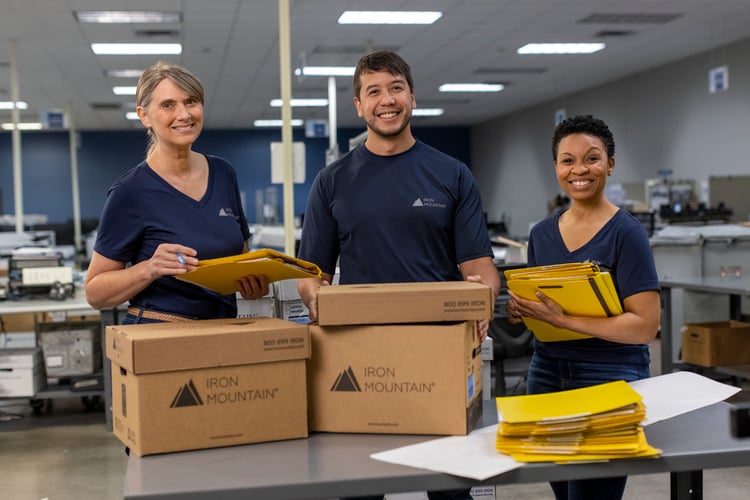Emergence of warehousing as a service
Iron Mountain's Warehousing as a Service can help you build a more agile supply chain

All you have to do is walk the aisles of your favorite store, and you will see sporadic empty shelves. It’s happening everywhere due to supply chain disruptions, and the problems do not appear to be going away any time soon.
"Disruptions to supply chain operations are set to stay, whether they be existing or new geopolitical conflicts, inflationary pressures and the recessionary environment, climate change weather events, or other issues yet to emerge."
Other factors include lingering influences from pandemic policies/lockdowns, strikes and protests at ports and railyards, and material shortage. If the last few years have shown us anything about the supply chain, it is just how vulnerable it is.
At the same time, e-commerce growth continues to put increasing pressure on resources that facilitate the storage and movement of merchandise. More and more products are being ordered online, which need to be supplied and delivered accurately and on time.
While the aforementioned disruptions have especially impacted the importation of goods, increasing both costs and transit times, the challenges unfortunately don’t stop once the materials reach our shores. Companies of all sizes are also having to overcome obstacles with domestic distribution, transportation, and fulfillment, making it more difficult to deliver goods to stores and customers in a timely and cost-effective manner.
Logistics challenges
While conditions have somewhat eased, the constantly evolving supply chain landscape continues to make warehouse space and logistics resources difficult to find and quite expensive in key markets. In fact, in the US and UK, warehouse vacancy rates remain among all time lows of between 3%-4%. Further compounding the problem, rising interest rates, economic uncertainty, and other factors have led to a decrease in warehouse construction starts, which will continue to impact vacancy rates into the future. The result is premium pricing for limited available space and resources, which can decimate profit margins and hamper growth efforts.
This has also created challenges for manufacturers and retailers who are focused on maintaining inventory levels that are able to satisfy sometimes unpredictable demand. In fact, due to the disruptions of the past few years as well as changing consumer purchasing habits (driven by high inflation and economic uncertainty), many businesses continue to hold elevated amounts of inventory and have been forced to find costly warehouse space to store it.
Ongoing disruptions, the growth of e-commerce, and varying demand have collectively prompted the need for more agile outsourced logistics solutions that enable fast, reliable, and cost-effective storage, distribution, and fulfillment of goods.
Problems with traditional solutions
Unfortunately, the changing supply chain environment has made it difficult for most organisations to solely rely on traditional logistics solutions—owned, leased, or outsourced via third-party logistics (3PL) companies.
Introducing warehousing as a service (WaaS)
New supply chain strategies are necessary to adapt to the changing environment, and the most prominent new model is warehousing as a service (WaaS). This nascent concept is about to explode as it provides the flexibility that organisations need to overcome current and future challenges and ultimately build a more resilient and sustainable supply chain.
WaaS solutions offer a network of local warehousing and fulfillment facilities throughout North America and the UK, along with the necessary labor resources and expertise to receive, securely store, and outbound goods both effectively and on time. These offerings provide options for short-term contracts, rapid onboarding, flexible service agreements, and a comprehensive set of value-added services such as container unloading, kitting, reverse logistics, and disposition.
| OWNED WAREHOUSE |
LEASED WAREHOUSE |
TRADITIONAL THIRD-PARTY LOGISTICS (3PL) |
WAREHOUSING AS A SERVICE (WAAS) |
|
|---|---|---|---|---|
| Upfront Investment Costs |
High | Medium | Low | None |
| Commitment Length |
Long-term | Long-term | Medium / Long-term | Flexible / Short-term |
| Capacity Scalability |
No | No | Limited | Yes |
| Location Scalability |
No | No | Limited | Yes |
| Labor Resources |
Not included | Not included | Yes | Yes |
The WaaS model is agile and provides on-demand flexibility at scale to handle overflow storage, seasonality, product launches, special projects, and other short- and long-term storage needs. WaaS facilities are located in key markets, and the WaaS model can both supplement owned, leased, or outsourced logistics models as well as offer organisations the flexibility to expand and grow without heavy CapEx or fixed OpEx expenses.
The point here is that organisations do not need to build or lock themselves into long-term contracts when they have constantly evolving challenges and growth strategies that could be supported by on-demand solutions. WaaS can help fulfill shorter-term or changing logistics needs when more expensive, traditional solutions are not required.
What’s next?
From weather events to geopolitical unrest, disruptions will continue to play a role in shaping the evolving logistics space. In addition, consumer demand is fickle and can change suddenly without notice. We have seen recently that our supply chain environment is volatile and unpredictable. Retailers and manufacturers need the versatility to flex and release in a manner commensurate with these external forces.
Traditional in-house and outsourced logistics solutions do not provide ample elasticity. Warehousing as a Service provides the necessary levels of agility, flexibility, and scalability that these organisations — and the supply chain as a whole — requires today, tomorrow, and into the future.
To see how Warehousing as a Service from Iron Mountain can help you build a more agile supply chain, visit www.ironmountain.com/en-gb/supplychain.
Related resources
View More Resources

